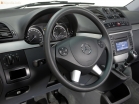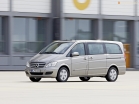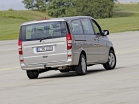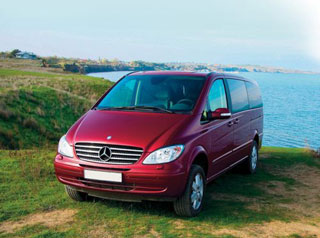Mercedes Benz Viano test drive since 2010 Minivan
Closer to the truth
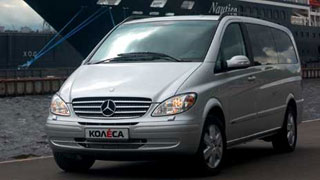 The Mercedes people really want everyone to think that Viano is a minivan. Keeper of family values \u200b\u200band a mobile home. Or a representative express in the service of the office, comfortable and high -speed at the same time. Well, they have every reason to want this, especially since Viano meets all the requirements for minivans: roomy, convenient, fast. Plus, the prestigious and expensive, which is very much even in Memstezovo. And very friendly in relation to the driver, guests, partners, the family to everyone who has to communicate with him.
The Mercedes people really want everyone to think that Viano is a minivan. Keeper of family values \u200b\u200band a mobile home. Or a representative express in the service of the office, comfortable and high -speed at the same time. Well, they have every reason to want this, especially since Viano meets all the requirements for minivans: roomy, convenient, fast. Plus, the prestigious and expensive, which is very much even in Memstezovo. And very friendly in relation to the driver, guests, partners, the family to everyone who has to communicate with him. However, that the gentlemen from Daimlerchrysler would not position themselves there, Viano is still not minivan. This is a real minibus. And the point is not that he actually copies the commercial van or, God forbid, the truck is like in management, no. It just has two important qualities that are almost unusual for cars on this scale: an incredible internal volume and a completely crazy number of execution options. Minivans are not capable of this.
Viano is available in many different options. By variating parameters such as the length of the wheelbase, the size of the rear history and the height of the body, you can create the same and unique minibus, which was required. Again, speaking of the engine, you also encounter the problem of choice: diesel and gasoline engines of various capacities are offered, the main of which, with a volume of 3.2 liters, develops 218 forces.
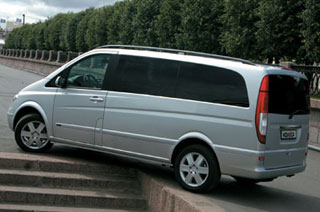 By the way, one can judge the status of a car by one very eloquent fact. Viano predecessor, in the spirit of passenger Mercedes, counted for one of the classes indicated by the letter V, was in the service of the President of Russia. The V-Class (or, as the Germans, FAU Class), in the amount of three pieces, accompanied the GDP in all its trips. Perhaps the appearance of such machines in the main motorcade of the country contributed to their popularity among ordinary mortals: three-year-old weshki climbed up to us from abroad.
By the way, one can judge the status of a car by one very eloquent fact. Viano predecessor, in the spirit of passenger Mercedes, counted for one of the classes indicated by the letter V, was in the service of the President of Russia. The V-Class (or, as the Germans, FAU Class), in the amount of three pieces, accompanied the GDP in all its trips. Perhaps the appearance of such machines in the main motorcade of the country contributed to their popularity among ordinary mortals: three-year-old weshki climbed up to us from abroad. The new minibus is radically different from its FAU predecessor. First of all, layout. As you know, the right Mercedes is the rear -wheel drive Mercedes. Any schoolboy who at least once in his life was holding a print edition with a machine on the cover will tell you this. So, Viano is closer to the truth: it is much more Mercedes than V-Class, because it has a drive to the rear wheels and, accordingly, the longitudinal location of the power unit. And since the transmission has gone from under the hood, it became possible to put more powerful engines. Incidentally, V-Class with its transversely located motor and front-wheel drive was extremely stingy on the engine compartment, and as a result, the most charged modification V 280 was equipped with an extremely compact, but extremely capricious and brittle engine from Volkswagen, thereby a row-v-V-V-VR6 VR6 . This power unit filed so tightly into the motor compartment of the minibus that it was actually jewelry work and maintenance.
A friend and I worked together on a diesel diesel Mercedes, and besides, a minibus is more than a logical combination. And the machine was very in the case. By the way, Viano is today the only minibus equipped with an automatic box with a sequental switch mode. In combination with a heavy -drawn diesel, the pseudo -rush loses all meaning: when the pedal drowned in the floor on any gear, the car very gloriously accelerates on the bare moment, without needing fussy switching down. It is even amazing how such a healthy bandura can so vigorously bring down on a seemingly modest 150-horsepower motor! Van’s ability is even more surprising: in the steering, of course, there is no acuteness, but the suspension is extremely collected and almost free.
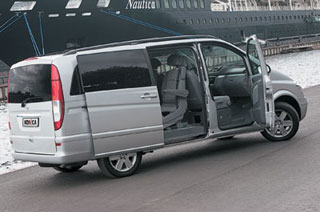 And yet, despite the pronounced liveliness of character and high potential opportunities, a large car was nevertheless created for peaceful life on the streets of cities, where there are no rally dopes, no circle records. But there are distances that need to be overcome quickly, but with proper comfort. This is the philosophy of any Mercedes. And here Viano is on top: the minibus is so simple, understandable and reliable in management that I just want to go and go. Enjoy life, think about something of your own, completely not distracted by the process itself. As if the car itself is driving, reading the legend from somewhere in your thoughts! No tension, continuous relaxation.
And yet, despite the pronounced liveliness of character and high potential opportunities, a large car was nevertheless created for peaceful life on the streets of cities, where there are no rally dopes, no circle records. But there are distances that need to be overcome quickly, but with proper comfort. This is the philosophy of any Mercedes. And here Viano is on top: the minibus is so simple, understandable and reliable in management that I just want to go and go. Enjoy life, think about something of your own, completely not distracted by the process itself. As if the car itself is driving, reading the legend from somewhere in your thoughts! No tension, continuous relaxation. Our silver Wenn was in a six -seater version: each of those present had his own chair. And here is what the chart of passenger places looks like in terms of driving comfort: the most trumped place next to the driver. The following are the places of the middle row, on which, however, you have to go with your back forward. And in the back row that is, in fact, over the rear wheels on irregularities, it is already shaking in order. Here: for the eating of compartment, there is a folding table in the cabin. Each passenger has direct access to his cup holder and ashtray. What you need!
And now about sad. Frankly inexpensive materials for finishing the salon, large gaps between the details are not that we find fault, but still the quality of the Spanish assembly (Viano is made at the Spanish factory Daimlerchrysler in Vitoria) could be better. What is natural for the vito working vito, on an expensive minibus looks rudely. At least, passenger Mercedes leave a much more favorable impression.
So, after all, this bus seems to be a passenger. Almost minivan, only more and more solid. And more expensive. However, for those who are eager to have a business class minibus, this is today the only option. Of course, there is also Volkswagen Multivan, also an expensive and serious car. However, whatever one may say, but there are no stars on it and will not be. And Viano has both a star and everything else.
Autography Mercedes-Benz Viano
Still known as: Vito
Predecessor: V-Class (1996)
Premiere: August 2003
Body: 3 executions in length
Engines: 2.2-3.2 l (109-218 hp)
Production: Spain
Expected replacement: 2010-11

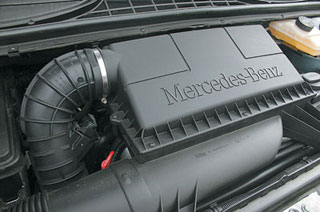
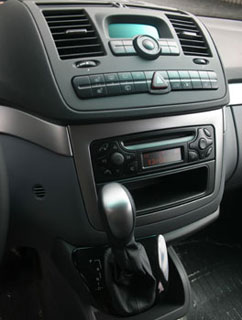
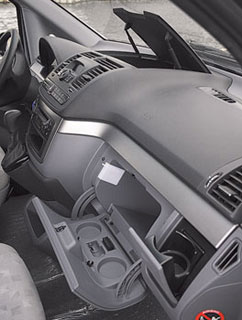
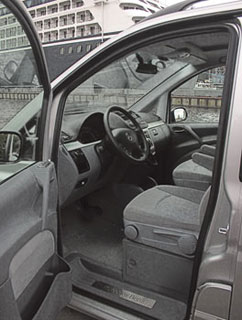
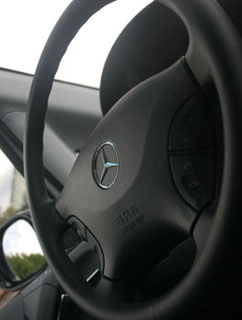
Source: Wheel magazine [No. 82/2004]



